by Graeme Hand
Summary: Good soil surface management can stop topsoil loss at the source. Soil needs full coverage, with litter between plants composting at the soil surface, to stop sheet erosion.
We have been managing our property for 25 months using Holistic Management. Ensuring the soil surface is well-covered at all times has made a dramatic difference in soil erosion, as the following photo demonstrates.
|
Graeme Hand
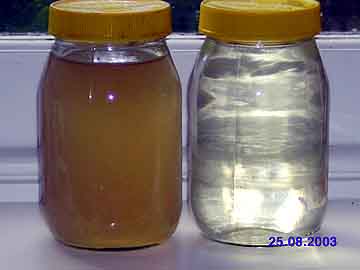 |
These samples were collected from the same stream after a 25mm (1") rainfall. Left: the water coming into our property. Right: the water leaving our property, 1500 m (0.9 mile) downstream. Approximately 200 hectares (500 acres) of our managed land drains into the stream.
Not streamside filtering
Graeme Hand
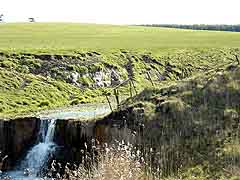 Muddy water pours into our property from continually grazed land upstream of the fence. Are short grass and livestock trails the cause?
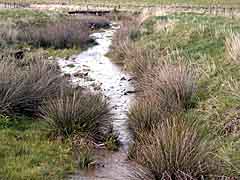 Conventionally restored stream where livestock are excluded carries a heavy soil load onto our property.
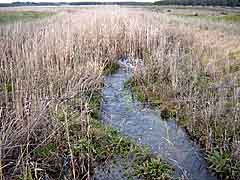 Clear water flowing off our holistically grazed property downstream of both photos.
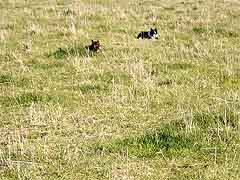 Our secret: soil protected from erosion with living plants and litter. Note excellent soil cover in this just-grazed pasture.
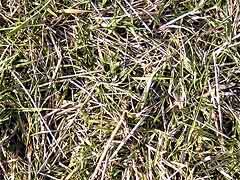 Soil surface. The space between living plants is well covered with dead material our livestock have trampled in. What you can't see is litter composting at the soil surface, which is the secret to stopping soil movement. |
What is going on? Not streamside filtering, as most people assume. This storm produced run off sufficient to move topsoil from grazing and cropping areas (right), and overload the filtering ability of any streamside vegetation.
The conventionally rehabilitated creek that drains into our creek is well-vegetated (second right). It is fenced, planted with trees, and managed by long-term rest. In photos, it looks the same as ours. Yet it is full of topsoil.
Covering the soil surface
When we started managing here, the part of the property that feeds the stream was a mix of continually grazed pasture and conventionally managed cropland. 80% of the ground was bare.
Today, 100% of this land is grazed pasture. 90% has full ground cover. We pasture crop some of it, drilling oats into our cool-season pastures. This allows us to keep the soil covered at all times while growing a crop, which we graze. The additional forage allows us to run high stock densities that are helping our native cool- and warm-season grasses re-establish. I especially like this idea as the oats provide grazing (income) and weed control, versus herbicide which exposes soil and costs money.
Holistic Management helped us increase cattle numbers from 79 head in 2001 to 313 head in 2003. High animal impact allows us to create excellent litter cover at the soil surface.
Many pastures that look visually similar to ours, with 100% ground cover, function very differently in terms of soil movement and water cycle. Only when mature litter (composting litter) is forming between the plants does soil stop moving. This mature litter binds the surface, so that trampling and runoff can not shift the soil. This was something I did not clearly understand until Mark Gardner and I monitored several other properties and compared to our own.
Why it works
Our management
- Protects the soil surface with live plants and litter so soil stays put and doesn't go into the water.
- Increases water infiltration, so more water soaks in and less runs off.
- Slows the stream's flow enough for soil from upstream to settle out of the water while on our property.
Spreading water quality know-how
Soil degradation and declining terms of trade are Australia's big agricultural issues. How do we move forward from here?I have started forming groups that are based on water quality at the lowest point on each person's farm. The groups bring water samples and then discuss what they are doing and how this impacts finances and quality of life.
With these trial-based learning groups we are looking at pasture cropping, no-till in brittle environments, and alternative crop residue digestion, while at the same time incorporating Holistic Management learning.
-- Graeme Hand
© 2003
Graeme Hand is a Holistic Management Certified Educator. Contact him for consulting or classes at:
G&S Hand and Associates P/L "Inverary" 150 Caroona Lane Branxholme Vic 3302 Australia Mobile: 0418532130
Posted 12 November 2003
Related articles and links